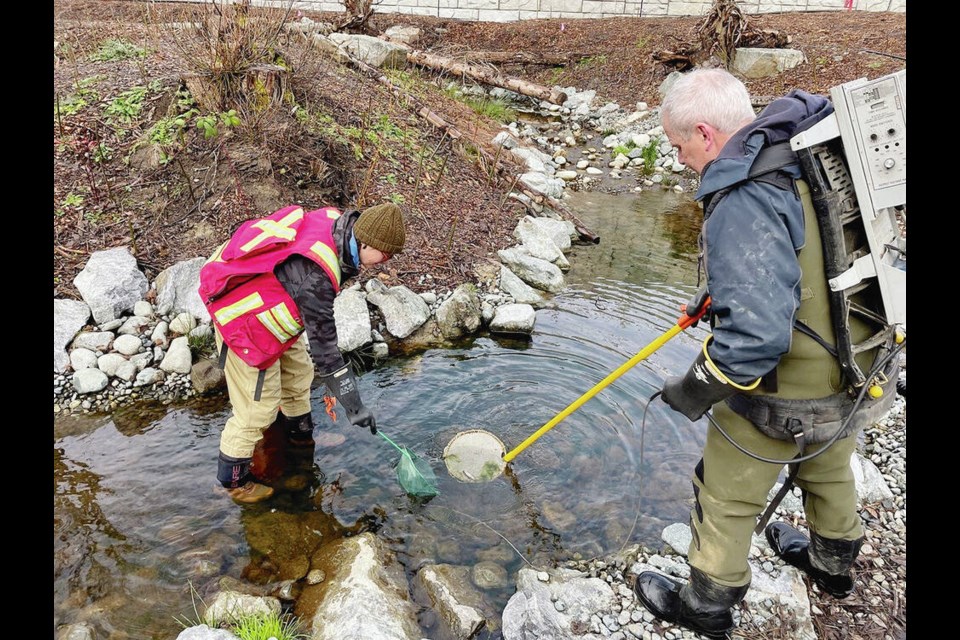It was just a ditch two years ago, clogged with fill from highway construction and choked by blackberries and weeds.
But now, a small stream around the new site of B.C. Transit’s HandyDART facility at Burnside Road and Watkiss Way in View Royal is a salmon-bearing tributary of Craigflower Creek.
Remediation efforts by B.C. Transit and legions of volunteers have transformed the seasonal waterway into a salmon habitat by changing its course and riparian areas.
New native plants and trees, strategically placed boulders and logs are attracting birds and insects — and that’s brought juvenile coho salmon out of Craigflower Creek and into the tributary’s pools and hiding places.
Scientists say their discovery of 27 cutthroat trout and coho salmon so soon in the revitalized ditch is a promising sign for Craigflower Creek and the watershed that extends through View Royal and the Highlands.
“It’s very pleasing to see how many have come back and how healthy they are,” said Cori Barraclough, a biologist with Aqua-Tex Scientific, which is consulting with B.C. Transit on the stream’s revitalization.
“These fish are fat and robust, which is exactly what we want to see.”
Rocks and weirs break up the stream’s flow, introduce oxygen and reduce stream-bank erosion.
Barraclough said that’s “created a kitchen to fatten fish up before they go out into the ocean,” vastly increasing their chances of survival.
The juvenile fish are attracted by insects, a chief food source, as they over-winter in the tributary, grow their silvery scales as smolts and prepare to head out of Craigflower Creek, down into Portage Inlet and eventually into the Pacific Ocean.
Contrary to public perception that all salmon come from major river systems like the Fraser or Goldstream, Barraclough said small creeks and tributaries like the Craigflower are important contributors to the coast’s salmon populations. “This might be small, but it’s a significant start,” she said.
The 12.5-kilometre Craigflower Creek has its source in the Highlands, is fed by tributaries and mixes in with several lakes, including Thetis Lake, as it flows into Portage Inlet.
The top of the watershed is still fairly pristine, but the creek flows into culverts and ditches as it travels through the watershed into more populated areas and under the Trans-Canada Highway twice and other major roadways, so preparing salmon habitats in the lower reaches of the creek is essential, said Barraclough.
Theresa Fresco, program manager for the Fraser Basin Council, said B.C. Transit’s plan for the stream is showing immediate results — and not just with the salmon.
Deer have arrived and American dippers and chickadees are feeding on insects, which are multiplying among the leaf litter in the water and along the banks. Garter snakes and frogs are showing up, too.
Last fall, the council recognized Transit’s HandyDART project as the first Salmon-Safe certified development on Vancouver Island.
“Salmon are a keystone species. If they are doing well, other species are going to do well,” said Fresco. “We see a project like this as a way forward in terms of how development overall needs to go.”
Fresco said developments don’t need to be next to a creek or stream. “If you follow the water, it all ends up in the watershed systems at some point,” she said.
So the runoff from roads, rooftops and landscapes “has to be of better quality and we have to ask ourselves how do we do better to green the [building and infrastructure] systems?”
The site was used for dumping fill when the Trans-Canada Highway was built, including the riparian zone of the seasonal stream, which has been moved at least once, possibly twice, in the last century.
The stream flow is made up of ground and stormwater from area roads and buildings. Water flow was variable, and the stream would go dry in summer, with the riparian zone providing little habitat value. Two coho salmon were discovered in the ditch before remediation and moved into Craigflower Creek.
B.C. Transit removed the fill and built nine new rain gardens covering a third of an acre to retain runoff during rainstorms. A trap at the top of the stream is designed to remove sediment and pollutants running off buildings and roads, providing cleaner water to Craigflower Creek.
B.C. Transit said water quality will be monitored and data provided to local stream keepers and agencies.
Its plan to restore the ecological health of the site involved moving the stream from the eastern edge of the property to the western and southern fringe, forming an arc that elongated the waterway from 150 metres to 250. The 30-metre-wide riparian area of just over an acre includes about 8,000 native plants.
Eagleview Elementary students planted the first plants in the stream in May 2022.
The $33-million HandyDART yard and dispatching facility is expected to be operational next year. The federal government is contributing $12.6 million, the province $12.9 million and the Victoria Regional Transit Commission $6.9 million.
HandyDART provides door-to-door shuttles for people with mobility challenges or disabilities. The service provides about 400,000 trips in the region per year and demand is growing.
The centre will occupy a portion of the nine-acre property with the remainder enhanced through sidewalks, landscaping and environmental restoration. About 1.5 acres along Watkiss Way has been given to the Town of View Royal for a new public space.
>>> To comment on this article, write a letter to the editor: [email protected]



